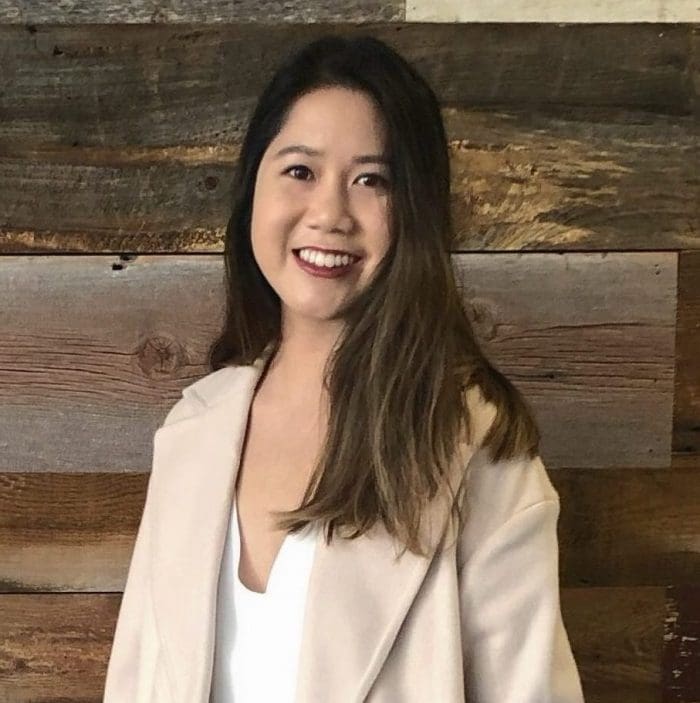At the start of Summer 2021 we welcomed 11 interns, all eager and excited to immerse themselves in the transportation profession! In addition to gaining experience with real-life project work, these students are also getting a taste of a hybrid work environment, as this internship mirrors Kittelson’s new flexible approach to work states (some working from the office, some working from home, and many doing a combination of both).
Now that they’ve made it to the halfway point in the program, we asked five of our interns to share what they’ve learned over the last few weeks, including insights for other students evaluating hybrid work environments. Here is what Lauren Zuend, Karen Phan, Lauren Prunkl, Jarvis Yuan, and Andreana Roxas have to say about their experience so far:
—
Q: What’s been the highlight of your internship so far?
 Lauren Z. – The highlights of my internship have been being the main analyst on two traffic impact studies, and visiting the Reston office in-person. The traffic impact studies were excellent learning experiences, and with each one I felt that I was able to understand more about how the impact study (and overall project development) process works. When visiting the Reston office, it was fun to meet everyone there in-person, go on a few walks, and get to know the interns that visited!
Lauren Z. – The highlights of my internship have been being the main analyst on two traffic impact studies, and visiting the Reston office in-person. The traffic impact studies were excellent learning experiences, and with each one I felt that I was able to understand more about how the impact study (and overall project development) process works. When visiting the Reston office, it was fun to meet everyone there in-person, go on a few walks, and get to know the interns that visited!
 Karen P. – The highlight of my internship so far will have to be the Intern Jamboree, where all the interns get together to bond and participate in workshops, informative sessions, and other activities! Joe Toole, Lauren Hunt, and Russ Doubleday did a great job hosting and leading the jamboree! It was a great blend of applying transportation skills, socializing with fellow interns, and learning more about Kittelson.
Karen P. – The highlight of my internship so far will have to be the Intern Jamboree, where all the interns get together to bond and participate in workshops, informative sessions, and other activities! Joe Toole, Lauren Hunt, and Russ Doubleday did a great job hosting and leading the jamboree! It was a great blend of applying transportation skills, socializing with fellow interns, and learning more about Kittelson.
 Lauren P. – I’ve enjoyed jumping in on several different projects. One that has stood out is a corridor study in and around Tampa, FL. Last semester, I completed a semester long corridor study project exercise for school for a road connecting Durham and Chapel Hill, NC. It’s been great to be involved throughout the summer with the Tampa project and see how these types of projects take shape in practice.
Lauren P. – I’ve enjoyed jumping in on several different projects. One that has stood out is a corridor study in and around Tampa, FL. Last semester, I completed a semester long corridor study project exercise for school for a road connecting Durham and Chapel Hill, NC. It’s been great to be involved throughout the summer with the Tampa project and see how these types of projects take shape in practice.
Q: What’s something you’ve learned that you didn’t expect to learn?
 Lauren Z. – I didn’t expect to learn how to balance my work schedule between having too many projects to work on vs. not enough to fill my hours. I am still in the process of learning how to do so (and will likely continue to learn until the end of my internship), but it is a good skill to know how long tasks will take and how much work I can take on at one time.
Lauren Z. – I didn’t expect to learn how to balance my work schedule between having too many projects to work on vs. not enough to fill my hours. I am still in the process of learning how to do so (and will likely continue to learn until the end of my internship), but it is a good skill to know how long tasks will take and how much work I can take on at one time.
 Lauren P. – I didn’t expect to learn so much about the Florida Department of Transportation’s policies and processes for implementation such as Context Classification and Complete Streets. I had the opportunity to assist with the Context Classification process for the existing conditions phase of the corridor study project as well as see how Complete Streets is implemented through the Resurfacing, Restoration and Rehabilitation (RRR) process for example.
Lauren P. – I didn’t expect to learn so much about the Florida Department of Transportation’s policies and processes for implementation such as Context Classification and Complete Streets. I had the opportunity to assist with the Context Classification process for the existing conditions phase of the corridor study project as well as see how Complete Streets is implemented through the Resurfacing, Restoration and Rehabilitation (RRR) process for example.
 Jarvis Y. – I was introduced to the design and operation of signal systems in one of the many intern tech sessions and Meet & Greet with Yi-Min Ha. I also got to work with Abby Morgan and Ross Buchan on an application research task for a connected vehicle project, where I researched many case studies on connected vehicles hardware usage, Signal Phase and Timing (SPaT) messaging applications, and most importantly, the lesson learned for some of the deployment corridors. The complexity and challenges of the deployment of hardware on a corridor and network level really got me interested in this subject and I’m planning to take some classes on signal design and ITS when I return to college in the fall.
Jarvis Y. – I was introduced to the design and operation of signal systems in one of the many intern tech sessions and Meet & Greet with Yi-Min Ha. I also got to work with Abby Morgan and Ross Buchan on an application research task for a connected vehicle project, where I researched many case studies on connected vehicles hardware usage, Signal Phase and Timing (SPaT) messaging applications, and most importantly, the lesson learned for some of the deployment corridors. The complexity and challenges of the deployment of hardware on a corridor and network level really got me interested in this subject and I’m planning to take some classes on signal design and ITS when I return to college in the fall.
Q: What are the advantages and disadvantages of a hybrid internship?
 Lauren Z. – The hybrid structure of the internship has its pros and cons. A few pros include having more flexibility to steer how my days look in terms of when I want to schedule to work on the 40 hours per week. Another pro is being able to go places with my family while still being able to make progress on Kittelson projects. Some cons include not being able to build the in-person connections with fellow interns and coworkers, and not spending time immersed in the Kittelson office culture.
Lauren Z. – The hybrid structure of the internship has its pros and cons. A few pros include having more flexibility to steer how my days look in terms of when I want to schedule to work on the 40 hours per week. Another pro is being able to go places with my family while still being able to make progress on Kittelson projects. Some cons include not being able to build the in-person connections with fellow interns and coworkers, and not spending time immersed in the Kittelson office culture.
 Karen P. – My internship so far has been completely virtual but I’m planning to visit the Orange and Boise offices during my internship, which will be nice. The hybrid-structure allows flexibility in work location: I’m assigned to the Boise office but working from California!
Karen P. – My internship so far has been completely virtual but I’m planning to visit the Orange and Boise offices during my internship, which will be nice. The hybrid-structure allows flexibility in work location: I’m assigned to the Boise office but working from California!
 Lauren P. – The flexibility of the hybrid-structure made me feel comfortable when making my decision to join for the summer since there was still a lot of uncertainty with the pandemic in early spring. As the summer has gone on, it is nice to have the option to visit offices since I have been working remotely. Since the company often operates remotely for cross-office collaboration, it was also easy to jump in remotely and not feel isolated.
Lauren P. – The flexibility of the hybrid-structure made me feel comfortable when making my decision to join for the summer since there was still a lot of uncertainty with the pandemic in early spring. As the summer has gone on, it is nice to have the option to visit offices since I have been working remotely. Since the company often operates remotely for cross-office collaboration, it was also easy to jump in remotely and not feel isolated.
 Andreana R. – I enjoy the hybrid-structure of this internship. Even though my internship was mostly virtual, I had the chance to go on a field visit and office visits to meet other interns and Kittelson staff. I think working virtually can typically make an individual feel more isolated, but Kittelson staff and my mentors have welcomed me and it has been very interactive!
Andreana R. – I enjoy the hybrid-structure of this internship. Even though my internship was mostly virtual, I had the chance to go on a field visit and office visits to meet other interns and Kittelson staff. I think working virtually can typically make an individual feel more isolated, but Kittelson staff and my mentors have welcomed me and it has been very interactive!
 Jarvis Y. – As one of the full-time “Zoom University” students that has been keeping with the remote curriculum for the last year, I feel like the hybrid-structure of the internship has its pro and cons and it is different from person to person. Some pros are the money and time saved from not having to commute, easier transition from a remote semester to a work-from-home internship, and mentors/PMs being “a Teams call away.” Some cons are increased screen time, missing out on daily interactions and learning/bonding that can happen in an office, and there is potential for more distractions at home.
Jarvis Y. – As one of the full-time “Zoom University” students that has been keeping with the remote curriculum for the last year, I feel like the hybrid-structure of the internship has its pro and cons and it is different from person to person. Some pros are the money and time saved from not having to commute, easier transition from a remote semester to a work-from-home internship, and mentors/PMs being “a Teams call away.” Some cons are increased screen time, missing out on daily interactions and learning/bonding that can happen in an office, and there is potential for more distractions at home.
Q: After navigating a hybrid-structure, how do you feel about future hybrid opportunities?
 Karen P. – The COVID pandemic has shown that a hybrid-structure is doable and can work well with many organizations. It feels like the best of both worlds: you’re able to have valuable in-person interactions with your colleagues, but are afforded more flexibility in your schedule and location.
Karen P. – The COVID pandemic has shown that a hybrid-structure is doable and can work well with many organizations. It feels like the best of both worlds: you’re able to have valuable in-person interactions with your colleagues, but are afforded more flexibility in your schedule and location.
 Andreana R. – I definitely prefer hybrid working conditions after having a mostly virtual, but hybrid internship. I think the benefits of working virtually are being able to save on commute, being able to see my dog more, and being equally as productive working from home.
Andreana R. – I definitely prefer hybrid working conditions after having a mostly virtual, but hybrid internship. I think the benefits of working virtually are being able to save on commute, being able to see my dog more, and being equally as productive working from home.
 Jarvis Y. – I would generally welcome the change for a hybrid working format, and it should benefit both the company and individuals. It might also enable the possibility for expanding the service to nearby/different regions without physically having an office in the region.
Jarvis Y. – I would generally welcome the change for a hybrid working format, and it should benefit both the company and individuals. It might also enable the possibility for expanding the service to nearby/different regions without physically having an office in the region.
Q: What can a company do to make hybrid work environments more effective?
 Lauren Z. – To make hybrid structures more valuable, companies can provide trainings/resources about software such as Outlook and Microsoft Teams for those who aren’t familiar with them. Companies can also promote virtual meet-ups and activities so that those who work more virtually still feel included in the company culture.
Lauren Z. – To make hybrid structures more valuable, companies can provide trainings/resources about software such as Outlook and Microsoft Teams for those who aren’t familiar with them. Companies can also promote virtual meet-ups and activities so that those who work more virtually still feel included in the company culture.
 Lauren P . – Providing opportunities for connection outside of project work helps make this structure work well. Check-ins to see how the structure is working and what can be improved every so often helps adjust and continue what is working well.
Lauren P . – Providing opportunities for connection outside of project work helps make this structure work well. Check-ins to see how the structure is working and what can be improved every so often helps adjust and continue what is working well.
 Andreana R. – I think virtual events like game nights, jeopardy, etc. are pretty fun and allows for that interaction even if it’s virtual.
Andreana R. – I think virtual events like game nights, jeopardy, etc. are pretty fun and allows for that interaction even if it’s virtual.
 Jarvis Y. – Forming committees, if the resource allows, to engage different levels of staff in conversations and discussions. These could be related to emerging tech in respective fields, software tips & tricks, productivity seminars, TV shows & sports group, etc. The idea here is to make up the socializing part that’s missing from the remote working environment. Alternatively, it could also be scheduled weekly check-ins across staff levels. People can use this time to discuss recent trends, things of interest, or share opinions on common topics that matters to them.
Jarvis Y. – Forming committees, if the resource allows, to engage different levels of staff in conversations and discussions. These could be related to emerging tech in respective fields, software tips & tricks, productivity seminars, TV shows & sports group, etc. The idea here is to make up the socializing part that’s missing from the remote working environment. Alternatively, it could also be scheduled weekly check-ins across staff levels. People can use this time to discuss recent trends, things of interest, or share opinions on common topics that matters to them.
Q: Any words of wisdom for future interns?
 Lauren Z. – An important piece of advice to keep in mind is being open to feedback. As an intern, you aren’t expected to know all of the answers and mistakes are inevitable; however, it is important to learn how you can improve on your work and continuously be better at the profession you’re exploring.
Lauren Z. – An important piece of advice to keep in mind is being open to feedback. As an intern, you aren’t expected to know all of the answers and mistakes are inevitable; however, it is important to learn how you can improve on your work and continuously be better at the profession you’re exploring.
 Karen P. – As interns, we come in with a general sense of our interests but I would also encourage future interns to be flexible! Try out different projects, work on different teams — you might find you have an interest in the topic! Keep a clear line of communication between yourself and your PM and mentors, network, and remember to relax and enjoy the internship!
Karen P. – As interns, we come in with a general sense of our interests but I would also encourage future interns to be flexible! Try out different projects, work on different teams — you might find you have an interest in the topic! Keep a clear line of communication between yourself and your PM and mentors, network, and remember to relax and enjoy the internship!
 Lauren P. – 1. Figure out an organizational structure that works well for you at the beginning of your internship. I started using One Note for the first time which is great for having everything recorded in one place. Also, track your project work. I met with someone at the beginning of my internship who recommended I keep a log of project titles, location, my role, and how I contributed. That way, it is easy to reference for the future.
Lauren P. – 1. Figure out an organizational structure that works well for you at the beginning of your internship. I started using One Note for the first time which is great for having everything recorded in one place. Also, track your project work. I met with someone at the beginning of my internship who recommended I keep a log of project titles, location, my role, and how I contributed. That way, it is easy to reference for the future.
 Andreana R. – 1. Take full advantage of your internship and make connections. 2. Don’t be afraid to ask questions and make mistakes, but make sure you understand the concept and fix them!
Andreana R. – 1. Take full advantage of your internship and make connections. 2. Don’t be afraid to ask questions and make mistakes, but make sure you understand the concept and fix them!
 Jarvis Y. – Express your interests up-front. Be organized and pay attention to documentation. Ask for the final memo/report from your PM to read over. Master using Outlook and other personal calendars.
Jarvis Y. – Express your interests up-front. Be organized and pay attention to documentation. Ask for the final memo/report from your PM to read over. Master using Outlook and other personal calendars.
—
We appreciate these students’ insights and look forward to finishing out our 2021 internship program! Get to know our 2021 intern class here, and learn more about internships with Kittelson here.
